Your Time has Finished
Which UCAT Exam
are you sitting?
Loading...
AR Mini Mock 3
Your Score:
Average Score of All Users:
You performed better than of students
Section Breakdown
| Your Score | Average of all Users | Percentile | |
|---|---|---|---|
| AR Set 9 |
AR Set 9
Your score:
Average score:
You performed better than of students
Abstract Reasoning Practice Subtest Instructions
There are 4 different question types in this section of the exam.
For type 1, you will be presented with two sets of shapes labelled “Set A” and “Set B”. You will be given a test shape and asked to decide whether the test shape belongs to Set A, Set B, or Neither.
For type 2, you will be presented with a series of shapes. You will be asked to select the next shape in series.
For type 3, you will be presented with a statement, involving a group of shapes. You will be asked to determine which shape completes the statement.
For type 4, you will be presented with two sets of shapes labelled “Set A” and “Set B”. You will be asked to select which of the four response options belongs to Set A or Set B.
It is in your best interest to answer all questions as there is no penalty for guessing. All unanswered questions will be scored as incorrect.
Click the Next (N) button to proceed.

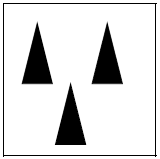
Explanation
Pattern
SET A: There is an even number of shapes. All shapes with two or more lines of symmetry are shaded, while shapes with one line of symmetry are unshaded.
SET B: There is an odd number of shapes. All shapes with two or more lines of symmetry are unshaded, while shapes with one line of symmetry are shaded.
The correct answer is B.
All three shapes have one line of symmetry and therefore they are all shaded.
Top tip: Always start with the simplest box first to work out the pattern. The greater the number of shapes, the greater the number of potential patterns, so start with the simplest visually.

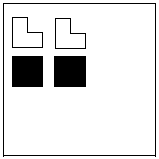
Explanation
Pattern
SET A: There is an even number of shapes. All shapes with two or more lines of symmetry are shaded, while shapes with one line of symmetry are unshaded.
SET B: There is an odd number of shapes. All shapes with two or more lines of symmetry are unshaded, while shapes with one line of symmetry are shaded.
The correct answer is A.
There are four shapes. The squares have more than 1 line of symmetry and are shaded, while shapes with one line of symmetry only are unshaded.
Top tip: Always start with the simplest box first to work out the pattern. The greater the number of shapes, the greater the number of potential patterns, so start with the simplest visually.

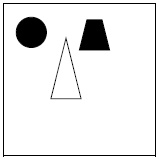
Explanation
Pattern
SET A: There is an even number of shapes. All shapes with two or more lines of symmetry are shaded, while shapes with one line of symmetry are unshaded.
SET B: There is an odd number of shapes. All shapes with two or more lines of symmetry are unshaded, while shapes with one line of symmetry are shaded.
The correct answer is C.
The trapezium and triangle have different shading, even though they both have one line of symmetry.
Top tip: Always start with the simplest box first to work out the pattern. The greater the number of shapes, the greater the number of potential patterns, so start with the simplest visually.

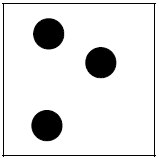
Explanation
Pattern
SET A: There is an even number of shapes. All shapes with two or more lines of symmetry are shaded, while shapes with one line of symmetry are unshaded.
SET B: There is an odd number of shapes. All shapes with two or more lines of symmetry are unshaded, while shapes with one line of symmetry are shaded.
The correct answer is C.
There are three shapes, but this cannot be in Set B since the circles (with infinite lines of symmetry) are shaded.
Top tip: Always start with the simplest box first to work out the pattern. The greater the number of shapes, the greater the number of potential patterns, so start with the simplest visually.

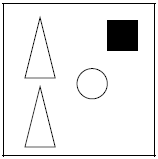
Explanation
Pattern
SET A: There is an even number of shapes. All shapes with two or more lines of symmetry are shaded, while shapes with one line of symmetry are unshaded.
SET B: There is an odd number of shapes. All shapes with two or more lines of symmetry are unshaded, while shapes with one line of symmetry are shaded.
The correct answer is C.
There are four shapes, but this cannot belong to Set A as the circle is unshaded.
Top tip: Always start with the simplest box first to work out the pattern. The greater the number of shapes, the greater the number of potential patterns, so start with the simplest visually.

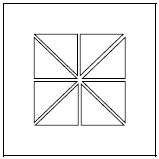
Explanation
Pattern
SET A: There are eight triangles. If an even number of triangles is shaded, then it will be arranged in a square shape. If an odd number of triangles is shaded, it will be arranged in a diamond shape.
SET B: There are eight triangles. If an odd number of triangles is shaded, then it will be arranged in a square shape. If an even number of triangles is shaded, it will be arranged in a diamond shape.
The correct answer is A.
An even number of triangles is shaded and the shape is arranged in a square, so this belongs to set A.
Timing tip: Try to work out how long each question should take you for each section. This is particularly important for the AR section, because you should be spending around 1 minute on each set of 5 questions. If it is taking too long to work out, flag the questions and move on.

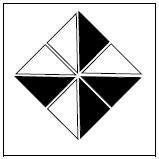
Explanation
Pattern
SET A: There are eight triangles. If an even number of triangles is shaded, then it will be arranged in a square shape. If an odd number of triangles is shaded, it will be arranged in a diamond shape.
SET B: There are eight triangles. If an odd number of triangles is shaded, then it will be arranged in a square shape. If an even number of triangles is shaded, it will be arranged in a diamond shape.
The correct answer is B.
An even number of triangles is shaded and it is arranged in a diamond shape, so this belongs to set B.
Timing tip: Try to work out how long each question should take you for each section. This is particularly important for the AR section, because you should be spending around 1 minute on each set of 5 questions. If it is taking too long to work out, flag the questions and move on.

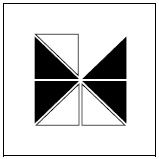
Explanation
Pattern
SET A: There are eight triangles. If an even number of triangles is shaded, then it will be arranged in a square shape. If an odd number of triangles is shaded, it will be arranged in a diamond shape.
SET B: There are eight triangles. If an odd number of triangles is shaded, then it will be arranged in a square shape. If an even number of triangles is shaded, it will be arranged in a diamond shape.
The correct answer is C.
This belongs to neither set as there are only seven triangles.
Timing tip: Try to work out how long each question should take you for each section. This is particularly important for the AR section, because you should be spending around 1 minute on each set of 5 questions. If it is taking too long to work out, flag the questions and move on.

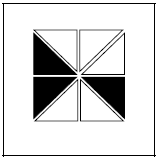
Explanation
Pattern
SET A: There are eight triangles. If an even number of triangles is shaded, then it will be arranged in a square shape. If an odd number of triangles is shaded, it will be arranged in a diamond shape.
SET B: There are eight triangles. If an odd number of triangles is shaded, then it will be arranged in a square shape. If an even number of triangles is shaded, it will be arranged in a diamond shape.
The correct answer is B.
There is an odd number of shaded triangles and it is arranged in a square shape. Therefore this belongs to set B.
Timing tip: Try to work out how long each question should take you for each section. This is particularly important for the AR section, because you should be spending around 1 minute on each set of 5 questions. If it is taking too long to work out, flag the questions and move on.

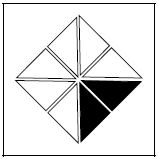
Explanation
Pattern
SET A: There are eight triangles. If an even number of triangles is shaded, then it will be arranged in a square shape. If an odd number of triangles is shaded, it will be arranged in a diamond shape.
SET B: There are eight triangles. If an odd number of triangles is shaded, then it will be arranged in a square shape. If an even number of triangles is shaded, it will be arranged in a diamond shape.
The correct answer is B.
An even number of triangles is shaded, and this is arranged in a diamond shape. Therefore, this belongs to set A.
Timing tip: Try to work out how long each question should take you for each section. This is particularly important for the AR section, because you should be spending around 1 minute on each set of 5 questions. If it is taking too long to work out, flag the questions and move on.

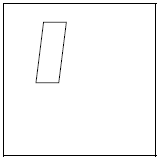
Explanation
Pattern
SET A: Each figure contains only one white circle. There is an odd number of shapes within the set.
SET B: Each figure contains only one black square. There is an even number of shapes within the set.
The correct answer is C.
There is neither a white circle nor a black square within the figure, so this belongs to neither set.
 K
Medicmind Tutor
K
Medicmind Tutor
Wed, 22 Dec 2021 08:28:41
For set A, left middle box is even number of shapes....

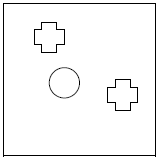
Explanation
Pattern
SET A: Each figure contains only one white circle. There is an odd number of shapes within the set.
SET B: Each figure contains only one black square. There is an even number of shapes within the set.
The correct answer is A.
There is an odd number of shapes and a white circle, so this belongs to set A.

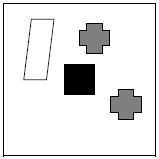
Explanation
Pattern
SET A: Each figure contains only one white circle. There is an odd number of shapes within the set.
SET B: Each figure contains only one black square. There is an even number of shapes within the set.
The correct answer is B.
There is an even number of shapes and a black square, so this belongs to set B.

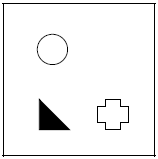
Explanation
Pattern
SET A: Each figure contains only one white circle. There is an odd number of shapes within the set.
SET B: Each figure contains only one black square. There is an even number of shapes within the set.
The correct answer is A.
There is an odd number of shapes and a white circle, so this belongs to set A.

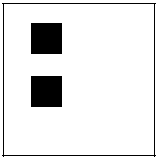
Explanation
Pattern
SET A: Each figure contains only one white circle. There is an odd number of shapes within the set.
SET B: Each figure contains only one black square. There is an even number of shapes within the set.
The correct answer is C.
There are two black squares, so this cannot belong to set B. Therefore, this belongs to neither set.

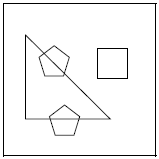
Explanation
Pattern
SET A: There is an odd number of shapes that are intersecting. All intersections are between shapes with an odd number of sides.
SET B: There is an even number of shapes that are intersecting. All intersections are between shapes with an even number of sides.
The correct answer is C.
There is an even number of shapes intersecting, but these are between shapes with an odd number of sides, so this belongs to neither set.
Top tip: Try to memorise some ‘triggers’ for certain patterns. For example, the presence of lines should trigger you to think about the number of intersections or enclosed spaces as a possible pattern.
 Wassay Khan
Medicmind Tutor
Wassay Khan
Medicmind Tutor
Wed, 03 Aug 2022 16:13:48
I think this pattern and the answers are wrong, because in set b you got intersections between odd number of shapes whereas in set A, there's intersections between even number of shapes.
 Wassay Khan
Medicmind Tutor
Wassay Khan
Medicmind Tutor
Wed, 03 Aug 2022 16:14:02
H

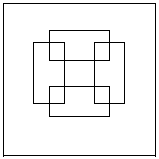
Explanation
Pattern
SET A: There is an odd number of areas of intersections. All intersections are between shapes with an odd number of sides.
SET B: There is an even number of areas of intersections. All intersections are between shapes with an even number of sides.
The correct answer is B.
There is an even number of intersections between shapes with an even number of sides, so this belongs to set B.
Top tip: Try to memorise some ‘triggers’ for certain patterns. For example, the presence of lines should trigger you to think about the number of intersections or enclosed spaces as a possible pattern.

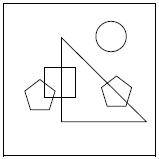
Explanation
Pattern
SET A: There is an odd number of intersections. All intersections are between shapes with an odd number of sides.
SET B: There is an even number of intersections. All intersections are between shapes with an even number of sides.
The correct answer is C.
The intersections are between shapes with even and odd numbers of sides, so this belongs to neither set.
Top tip: Try to memorise some ‘triggers’ for certain patterns. For example, the presence of lines should trigger you to think about the number of intersections or enclosed spaces as a possible pattern.

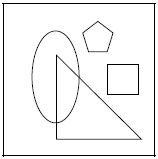
Explanation
Pattern
SET A: There is an odd number of intersections. All intersections are between shapes with an odd number of sides.
SET B: There is an even number of intersections. All intersections are between shapes with an even number of sides.
The correct answer is A.
There is one intersection between two shapes with odd numbers of sides, so this belongs to set A.
Top tip: Try to memorise some ‘triggers’ for certain patterns. For example, the presence of lines should trigger you to think about the number of intersections or enclosed spaces as a possible pattern.

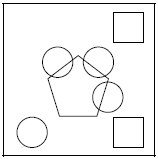
Explanation
Pattern
SET A: There is an odd number of intersections. All intersections are between shapes with an odd number of sides.
SET B: There is an even number of intersections. All intersections are between shapes with an even number of sides.
The correct answer is A.
There are three intersections between shapes with an odd number of sides, so this belongs to set A.
Top tip: Try to memorise some ‘triggers’ for certain patterns. For example, the presence of lines should trigger you to think about the number of intersections or enclosed spaces as a possible pattern.

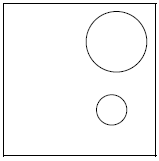
Explanation
Pattern
SET A: There is a shape in the top or bottom half of the figure. The number of circles in each figure corresponds to the number of sides of the shape. If the shape is in the top half of the figure, the circles will be shaded. If the shape is in the bottom half of the figure, the circles will be unshaded.
SET B: There is a shape in the top or bottom half of the figure. The number of circles in each figure corresponds to the number of sides of the shape. If the shape is in the top half of the figure, the circles will be unshaded. If the shape is in the bottom half of the figure, the circles will be shaded.
The correct answer is B.
There is a large circle in the top half of the figure, and a smaller unshaded circle, so this belongs to set B.
Common trap: Many candidates will only spot half the pattern – in this case we have number of sides and position. Try to work through all the possible patterns using SPONCS, because many AR sets in the UCAT will have multiple elements to the patterns.

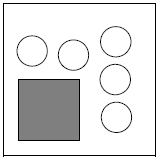
Explanation
Pattern
SET A: There is a shape in the top or bottom half of the figure. The number of circles in each figure corresponds to the number of sides of the shape. If the shape is in the top half of the figure, the circles will be shaded. If the shape is in the bottom half of the figure, the circles will be unshaded.
SET B: There is a shape in the top or bottom half of the figure. The number of circles in each figure corresponds to the number of sides of the shape. If the shape is in the top half of the figure, the circles will be unshaded. If the shape is in the bottom half of the figure, the circles will be shaded.
The correct answer is C.
This belongs to neither set as there is a square with four sides and five circles which do not correspond to the number of sides.
Common trap: Many candidates will only spot half the pattern – in this case we have number of sides and position. Try to work through all the possible patterns using SPONCS, because many AR sets in the UCAT will have multiple elements to the patterns.

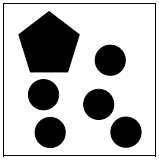
Explanation
Pattern
SET A: There is a shape in the top or bottom half of the figure. The number of circles in each figure corresponds to the number of sides of the shape. If the shape is in the top half of the figure, the circles will be shaded. If the shape is in the bottom half of the figure, the circles will be unshaded.
SET B: There is a shape in the top or bottom half of the figure. The number of circles in each figure corresponds to the number of sides of the shape. If the shape is in the top half of the figure, the circles will be unshaded. If the shape is in the bottom half of the figure, the circles will be shaded.
The correct answer is A.
There are five circles corresponding to five sides on the pentagon. These circles are shaded since the pentagon is in the top half of the shape. Therefore this belongs to set A.
Common trap: Many candidates will only spot half the pattern – in this case we have number of sides and position. Try to work through all the possible patterns using SPONCS, because many AR sets in the UCAT will have multiple elements to the patterns.

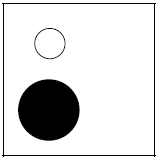
Explanation
Pattern
SET A: There is a shape in the top or bottom half of the figure. The number of circles in each figure corresponds to the number of sides of the shape. If the shape is in the top half of the figure, the circles will be shaded. If the shape is in the bottom half of the figure, the circles will be unshaded.
SET B: There is a shape in the top or bottom half of the figure. The number of circles in each figure corresponds to the number of sides of the shape. If the shape is in the top half of the figure, the circles will be unshaded. If the shape is in the bottom half of the figure, the circles will be shaded.
The correct answer is A.
There is one smaller circle corresponding to one side of the bigger circle. This is unshaded since the larger shape is in the bottom half. Therefore, this belongs to set A.
Common trap: Many candidates will only spot half the pattern – in this case we have number of sides and position. Try to work through all the possible patterns using SPONCS, because many AR sets in the UCAT will have multiple elements to the patterns.

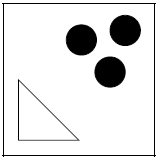
Explanation
Pattern
SET A: There is a shape in the top or bottom half of the figure. The number of circles in each figure corresponds to the number of sides of the shape. If the shape is in the top half of the figure, the circles will be shaded. If the shape is in the bottom half of the figure, the circles will be unshaded.
SET B: There is a shape in the top or bottom half of the figure. The number of circles in each figure corresponds to the number of sides of the shape. If the shape is in the top half of the figure, the circles will be unshaded. If the shape is in the bottom half of the figure, the circles will be shaded.
The correct answer is B.
There are three circles corresponding to three sides of the triangle. These are shaded since the triangle is in the bottom half, so this belongs to set B.
Common trap: Many candidates will only spot half the pattern – in this case we have number of sides and position. Try to work through all the possible patterns using SPONCS, because many AR sets in the UCAT will have multiple elements to the patterns.

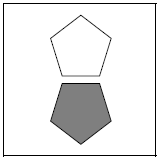
Explanation
Pattern
SET A: There is a vertical line of symmetry only.
SET B: There is a horizontal line of symmetry only.
The correct answer is A.
There is a vertical line of symmetry only.

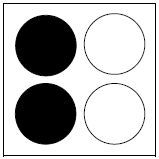
Explanation
Pattern
SET A: There is a vertical line of symmetry only.
SET B: There is a horizontal line of symmetry only.
The correct answer is B.
There is a horizontal line of symmetry only.

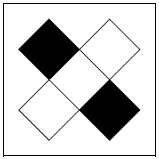
Explanation
Pattern
SET A: There is a vertical line of symmetry only.
SET B: There is a horizontal line of symmetry only.
The correct answer is C.
There is neither a horizontal nor a vertical line of symmetry.

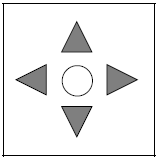
Explanation
Pattern
SET A: There is a vertical line of symmetry only.
SET B: There is a horizontal line of symmetry only.
The correct answer is C.
There is both a horizontal and vertical line of symmetry.

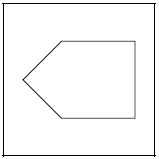
Explanation
Pattern
SET A: There is a vertical line of symmetry only.
SET B: There is a horizontal line of symmetry only.
The correct answer is B.
There is a horizontal line of symmetry only.

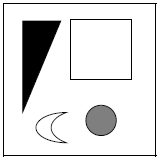
Explanation
Pattern
SET A: The total number of sides of all the shapes is 10. Colour and size are distractors.
SET B: The total number of sides of all the shapes is 11. Colour and size are distractors.
The correct answer is A.
The total number of sides adds up to 10, so this belongs to set A.
 Alexander Darby
Medicmind Tutor
Alexander Darby
Medicmind Tutor
Sat, 18 Sep 2021 11:08:25
Lol?

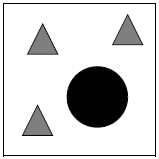
Explanation
Pattern
SET A: The total number of sides of all the shapes is 10. Colour and size are distractors.
SET B: The total number of sides of all the shapes is 11. Colour and size are distractors.
The correct answer is A.
The total number of sides adds up to 10, so this belongs to set A.

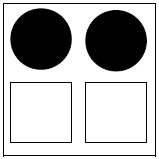
Explanation
Pattern
SET A: The total number of sides of all the shapes is 10. Colour and size are distractors.
SET B: The total number of sides of all the shapes is 11. Colour and size are distractors.
The correct answer is A.
The total number of sides adds up to 10, so this belongs to set A.

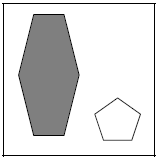
Explanation
Pattern
SET A: The total number of sides of all the shapes is 10. Colour and size are distractors.
SET B: The total number of sides of all the shapes is 11. Colour and size are distractors.
The correct answer is B.
The total number of sides adds up to 11, so this belongs to set B.

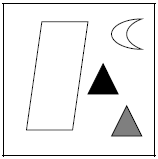
Explanation
Pattern
SET A: The total number of sides of all the shapes is 10. Colour and size are distractors.
SET B: The total number of sides of all the shapes is 11. Colour and size are distractors.
The correct answer is C.
The total number of sides adds up to 12, so this belongs to neither set.

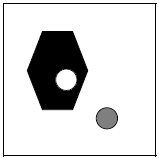
Explanation
Pattern
SET A: There is a large shape with a circle inside it and a circle outside it. The circle within the shape and outside the shape are the same colour.
SET B: There is a large shape with a circle inside it and a circle outside it. The circle outside the shape is the same colour as the shape itself.
The correct answer is C.
The colour of the shape and the colours of the two circles are different, meaning this cannot belong to either set.
Top tip: Try to focus on one set at a time when you are presented with a new set of patterns. For example, look at all of set A first and try to work out a pattern. Then look at set B and deduce its pattern; this is usually related to the pattern in set A somehow.

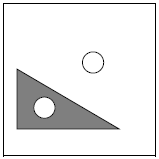
Explanation
Pattern
SET A: There is a large shape with a circle inside it and a circle outside it. The circle within the shape and outside the shape are the same colour.
SET B: There is a large shape with a circle inside it and a circle outside it. The circle outside the shape is the same colour as the shape itself.
The correct answer is A.
The circles inside and outside the shape are the same colour, so this belongs to set A.
Top tip: Try to focus on one set at a time when you are presented with a new set of patterns. For example, look at all of set A first and try to work out a pattern. Then look at set B and deduce its pattern; this is usually related to the pattern in set A somehow.

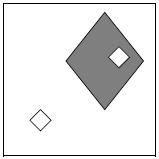
Explanation
Pattern
SET A: There is a large shape with a circle inside it and a circle outside it. The circle within the shape and outside the shape are the same colour.
SET B: There is a large shape with a circle inside it and a circle outside it. The circle outside the shape is the same colour as the shape itself.
The correct answer is C.
The colour of the shape and the colours of the two circles are different, meaning this cannot belong to either set.
Top tip: Try to focus on one set at a time when you are presented with a new set of patterns. For example, look at all of set A first and try to work out a pattern. Then look at set B and deduce its pattern; this is usually related to the pattern in set A somehow.
 A
Medicmind Tutor
A
Medicmind Tutor
Mon, 30 Aug 2021 18:45:08
Is the answer not set A?
 B
Medicmind Tutor
B
Medicmind Tutor
Wed, 01 Sep 2021 21:41:12
answering to A: NO i dont thinks so because the shape is not circle its diamonds

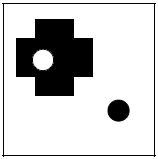
Explanation
Pattern
SET A: There is a large shape with a circle inside it and a circle outside it. The circle within the shape and outside the shape are the same colour.
SET B: There is a large shape with a circle inside it and a circle outside it. The circle outside the shape is the same colour as the shape itself.
The correct answer is B.
The circle outside the shape and the shape itself are the same colour.
Top tip: Try to focus on one set at a time when you are presented with a new set of patterns. For example, look at all of set A first and try to work out a pattern. Then look at set B and deduce its pattern; this is usually related to the pattern in set A somehow.

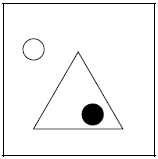
Explanation
Pattern
SET A: There is a large shape with a circle inside it and a circle outside it. The circle within the shape and outside the shape are the same colour.
SET B: There is a large shape with a circle inside it and a circle outside it. The circle outside the shape is the same colour as the shape itself.
The correct answer is B.
The circle outside the shape is the same colour as the triangle.
Top tip: Try to focus on one set at a time when you are presented with a new set of patterns. For example, look at all of set A first and try to work out a pattern. Then look at set B and deduce its pattern; this is usually related to the pattern in set A somehow.

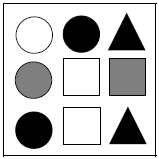
Explanation
Pattern
SET A: There are 9 shapes within each figure. There is always a row or column of three circles.
SET B: There are 9 shapes within each figure. There is always a row or column of three squares.
The correct answer is A.
There is a column of three circles, so this belongs to set A.
Top tip: Try not to get overwhelmed when you see many shapes in one box. When shapes are arranged like this in a geometrical way, the pattern almost always involves position.

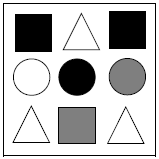
Explanation
Pattern
SET A: There are 9 shapes within each figure. There is always a row or column of three circles.
SET B: There are 9 shapes within each figure. There is always a row or column of three squares.
The correct answer is A.
There is a row of three circles, so this belongs to set A.
Top tip: Try not to get overwhelmed when you see many shapes in one box. When shapes are arranged like this in a geometrical way, the pattern almost always involves position.

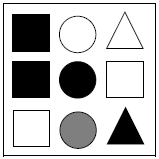
Explanation
Pattern
SET A: There are 9 shapes within each figure. There is always a row or column of three circles.
SET B: There are 9 shapes within each figure. There is always a row or column of three squares.
The correct answer is C.
There is not a line of circles or squares, so this belongs to neither set.
Top tip: Try not to get overwhelmed when you see many shapes in one box. When shapes are arranged like this in a geometrical way, the pattern almost always involves position.
 eb
Medicmind Tutor
eb
Medicmind Tutor
Mon, 25 Sep 2023 14:42:49
the answer is actually set b

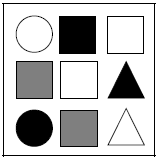
Explanation
Pattern
SET A: There are 9 shapes within each figure. There is always a row or column of three circles.
SET B: There are 9 shapes within each figure. There is always a row or column of three squares.
The correct answer is B.
There is a column of squares, so this belongs to set B.
Top tip: Try not to get overwhelmed when you see many shapes in one box. When shapes are arranged like this in a geometrical way, the pattern almost always involves position.

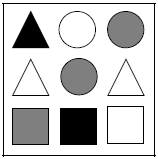
Explanation
Pattern
SET A: There are 9 shapes within each figure. There is always a row or column of three circles.
SET B: There are 9 shapes within each figure. There is always a row or column of three squares.
The correct answer is B.
There is a row of squares, so this belongs to set B.
Top tip: Try not to get overwhelmed when you see many shapes in one box. When shapes are arranged like this in a geometrical way, the pattern almost always involves position.

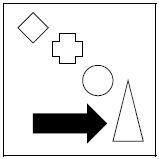
Explanation
Pattern
SET A: The arrow points to the shape with the greatest number of lines of symmetry.
SET B: The arrow points to the shape with the fewest lines of symmetry.
The correct answer is B.
The arrow is pointing to the triangle, which has the least number of lines of symmetry.

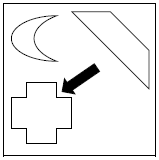
Explanation
Pattern
SET A: The arrow points to the shape with the greatest number of lines of symmetry.
SET B: The arrow points to the shape with the fewest lines of symmetry.
The correct answer is A.
The arrow is pointing to the shape with the most lines of symmetry.

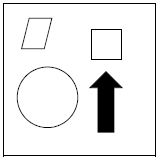
Explanation
Pattern
SET A: The arrow points to the shape with the greatest number of lines of symmetry.
SET B: The arrow points to the shape with the fewest lines of symmetry.
The correct answer is C.
The square has neither the most nor the least lines of symmetry.

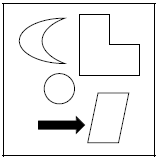
Explanation
Pattern
SET A: The arrow points to the shape with the greatest number of lines of symmetry.
SET B: The arrow points to the shape with the fewest lines of symmetry.
The correct answer is B.
The arrow is pointing to the shape with the least number of lines of symmetry.

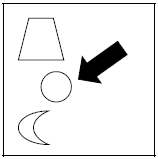
Explanation
Pattern
SET A: The arrow points to the shape with the greatest number of lines of symmetry.
SET B: The arrow points to the shape with the fewest lines of symmetry.
The correct answer is A.
The arrow is pointing to the shape with the greatest number of lines of symmetry.

Explanation
The correct answer is C.
The triangles alternate with shading – every four turns, the top and bottom triangles become unshaded, with spacing of two turns apart. The black circle moves clockwise by 2 spaces for each turn.

Explanation
The correct answer is D.
The arrow moves 90 degrees clockwise with each turn. The shading of the triangles also moves one space right with each turn. The position of the circle alternates between the top and the bottom, and the shading of the circle is the same as that of the triangle nearest to it.

Explanation
The correct answer is C.
The position of each of the shapes shifts clockwise with each turn. With each turn, the shapes are all rotated 45 degrees clockwise.

Explanation
The correct answer is A.
The arrows are rotated by 180 degrees. Each of the shapes ‘gains’ one side while keeping the same shading.
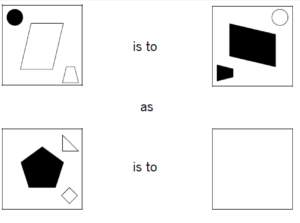
Explanation
The correct answer is D.
The entire image is rotated by 90 degrees in a clockwise direction. The shading of all shapes is inverted.
 A
Medicmind Tutor
A
Medicmind Tutor
Mon, 30 Aug 2021 18:49:37
One of the answer options is seen in the answer box.
AR Set 9 Review Screen
Instructions
Below is a summary of your answers. You can review your questions in three (3) different ways.
The buttons in the lower right-hand corner correspond to these choices:
1. Review all of your questions and answers.
2. Review questions that are incomplete.
3. Review questions that are flagged for review. (Click the 'flag' icon to change the flag for review status.)
You may also click on a question number to link directly to its location in the exam.
AR Set 9 Section
Final Answer Review Screen
Instructions
This review section allows you to view the answers you made and see whether they were correct or not. Each question accessed from this screen has an 'Explain Answer' button in the top left hand side. By clicking on this you will obtain an explanation as to the correct answer.
At the bottom of this screen you can choose to 'Review All' answers, 'Review Incorrect' answers or 'Review Flagged' answers. Alternatively you can go to specific questions by opening up any of the sub-tests below.
AR Set 9 Section
TI-108
Let's get acquainted ?
What is your name?
Nice to meet you, {{name}}!
What is your preferred e-mail address?
Nice to meet you, {{name}}!
What is your preferred phone number?
What is your preferred phone number?
Just to check, what are you interested in?
When should we call you?
What time works best for you? (UK Time)
How many hours of 1-1 tutoring are you looking for?
My WhatsApp number is...
For our safeguarding policy, please confirm...
For our safeguarding policy, please confirm...
Which online course are you interested in?
What is your query?
SubmitYou can apply for a bursary by clicking this link
https://www.medicmind.co.uk/medic-mind-foundation/Sure, what is your query?
SubmitLoading...
Thank you for your response.
We will aim to get back to you within 12-24 hours.
Lock in a 2 Hour 1-1 Tutoring Lesson Now
If you're ready and keen to get started click the button below to book your first 2 hour 1-1 tutoring lesson with us. Connect with a tutor from a university of your choice in minutes. (Use FAST5 to get 5% Off!)
Buy Now for £70